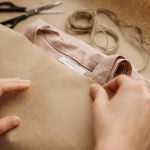You can safely breathe through polypropylene fabric because it offers a good balance of filtration and airflow. It effectively filters tiny particles like bacteria and viruses while allowing air to pass, reducing discomfort and heat buildup. Polypropylene is lightweight, moisture-wicking, and commonly used in masks for respiratory safety. Just be sure your mask fits well and has multiple layers for best protection. If you want to understand its full benefits and safety considerations, there’s more to explore.
Table of Contents
Key Takeaways
- Polypropylene fabric is generally safe to breathe through and is widely used in masks for effective filtration and breathability.
- It filters particles as small as 0.3 microns with electrostatic properties enhancing respiratory protection.
- Multiple polypropylene layers improve filtration while maintaining adequate airflow to prevent breathing difficulty.
- Proper mask fit and adjustable features reduce air leaks and increase respiratory safety and comfort.
- Some users may experience irritation or allergic reactions from fibers or chemical residues, so skin sensitivity should be considered.
What Is Polypropylene Fabric?
Polypropylene fabric is a type of synthetic material made from polymer fibers. When you touch it, you’ll notice it’s lightweight and resistant to moisture, which makes it unique compared to natural fabrics. You won’t find it absorbing water easily, so it dries quickly and resists stains.
Because of its chemical structure, it also resists many acids and alkalis, making it durable in various environments. You mightn’t realize that polypropylene is also breathable, allowing air to pass through while blocking liquids.
It’s a thermoplastic, so it melts rather than burns, which influences how it behaves under heat. Understanding these properties helps you see why polypropylene fabric is popular in many products, especially where durability and moisture resistance matter.
Common Uses of Polypropylene in Masks and Apparel
When you wear masks or certain activewear, there’s a good chance they contain polypropylene fibers. This fabric is popular because it’s lightweight, moisture-resistant, and durable.
In masks, polypropylene often serves as the middle filtering layer, trapping particles while letting air pass through. You’ll also find it in reusable and disposable face masks due to its effectiveness at filtering out contaminants without adding bulk.
In activewear, polypropylene helps wick sweat away from your skin, keeping you dry during workouts. Its quick-drying nature and resistance to odors make it ideal for sportswear, base layers, and thermal clothing.
Breathability Characteristics of Polypropylene Fabric
You’ll notice that polypropylene fabric offers varying levels of airflow permeability depending on its density.
It also excels at wicking moisture away from your skin, keeping you comfortable.
Understanding these factors helps you evaluate how breathable the fabric really is.
Airflow Permeability Levels
Although many fabrics offer protection, not all allow enough airflow for comfortable breathing. When you wear polypropylene fabric, you benefit from its moderate airflow permeability levels, which means air can pass through without much restriction.
This helps reduce the feeling of suffocation or heat buildup, making it easier for you to breathe over extended periods. However, the exact permeability varies depending on the fabric’s weave and thickness.
You’ll find that lightweight polypropylene fabrics let more air flow freely, while denser weaves might restrict airflow slightly but still maintain reasonable breathability.
Moisture Wicking Ability
Polypropylene fabric excels at wicking moisture away from your skin, keeping you dry and comfortable throughout the day. This ability is essential, especially if you wear masks or garments made from polypropylene for extended periods.
The fabric’s hydrophobic nature means it repels water rather than absorbing it, allowing sweat to move to the outer layer where it evaporates quickly. This reduces the damp feeling and helps maintain a cooler microclimate near your skin.
Here’s why polypropylene’s moisture-wicking ability matters for breathability:
- Prevents moisture buildup that can cause discomfort or skin irritation
- Helps maintain airflow by keeping the fabric dry
- Enhances overall hygiene by reducing bacterial growth associated with damp environments
Fabric Density Impact
When you choose fabric for breathability, density plays a crucial role in how easily air passes through polypropylene material. The tighter the weave or knit, the less air movement you’ll experience, which can make breathing feel restricted.
Conversely, a lower-density fabric has more open spaces, allowing better airflow and making it easier for you to breathe comfortably. However, lower density might reduce the fabric’s ability to block particles or provide insulation.
So, if you’re selecting polypropylene for masks or activewear, consider the balance between breathability and protection. You want enough density to filter effectively but not so much that it compromises comfort.
Understanding this trade-off helps you pick polypropylene fabrics that suit your specific respiratory needs.
Filtration Efficiency of Polypropylene in Face Masks
If you rely on face masks for protection, understanding how well polypropylene filters particles is essential.
Polypropylene is widely used in masks because it offers efficient filtration without sacrificing breathability. Its structure allows it to trap various particle sizes effectively.
Here’s what you should know about polypropylene’s filtration efficiency:
- It can filter out particles as small as 0.3 microns, including many airborne bacteria and viruses.
- The electrostatic charge in polypropylene fibers enhances particle capture, improving mask performance.
- Multi-layer polypropylene masks increase filtration efficiency by combining mechanical and electrostatic filtering.
Potential Respiratory Risks Associated With Polypropylene
Although polypropylene is praised for its filtration abilities, you should be aware of potential respiratory risks it might pose when used in face masks. Some users may experience irritation or allergic reactions, especially if the fabric isn’t properly processed. Additionally, improper mask use or extended wear could cause discomfort or breathing difficulty.
| Risk Type | Cause | Potential Effect |
|---|---|---|
| Irritation | Fibers or additives | Nasal or skin irritation |
| Allergic Reaction | Chemical residues | Sneezing, coughing |
| Breathing Difficulty | Tight fit or multiple layers | Shortness of breath |
| Contamination | Improper mask hygiene | Respiratory infections |
Comparison of Polypropylene to Other Mask Fabrics
Since choosing the right mask fabric can impact both comfort and protection, it’s important to understand how polypropylene compares to other common materials like cotton, polyester, and blends.
Polypropylene offers unique benefits but also differs in key ways.
- Filtration efficiency: Polypropylene generally filters particles better than cotton or polyester, thanks to its electrostatic properties.
- Breathability: It tends to be more breathable than tightly woven cotton but less so than some lightweight polyester blends.
- Moisture resistance: Unlike cotton, polypropylene repels moisture, reducing dampness that can affect breathability and comfort.
How Polypropylene Fabric Affects Comfort During Prolonged Use
When you wear polypropylene fabric for long periods, its moisture-wicking and breathability features play a crucial role in your comfort. The fabric pulls sweat away from your skin, keeping you dry and reducing irritation. Its lightweight nature means you won’t feel weighed down, even during extended use. However, because it’s not as soft as natural fibers, you might notice slight roughness against your skin over time.
| Feature | Benefit | Your Experience |
|---|---|---|
| Moisture-wicking | Keeps skin dry | Less sweat discomfort |
| Breathability | Allows airflow | Cooler, fresher feeling |
| Lightweight | Reduces bulk | Comfortable for hours |
Safety Standards and Regulations for Polypropylene Masks
Understanding how polypropylene fabric keeps you comfortable is just one part of the picture. You also need to know about the safety standards that guarantee these masks protect your respiratory health.
Polypropylene masks must meet strict regulations to confirm they filter particles effectively without compromising breathability. Look for certifications like NIOSH or ASTM, which validate mask quality and safety.
Regulatory bodies focus on:
- Filtration efficiency to block harmful particles
- Breathability standards to prevent discomfort or strain
- Material safety to avoid skin irritation or toxicity
When you choose a polypropylene mask compliant with these standards, you’re trusting a product tested for both protection and comfort. This guarantees you can breathe safely, even during extended wear.
Tips for Choosing Safe and Breathable Polypropylene Masks
Although many polypropylene masks look similar, choosing one that balances safety and breathability requires careful consideration. You should look for masks with multiple layers to guarantee filtration without sacrificing airflow. Check for certification labels like N95 or ASTM to verify safety standards. Also, consider the mask’s fit; a snug but comfortable fit prevents air leaks and improves protection.
Here’s a quick guide to help you pick the right mask:
| Feature | What to Look For | Why It Matters |
|---|---|---|
| Layers | At least 3 polypropylene layers | Enhances filtration |
| Certification | N95, ASTM, or equivalent | Guarantees proven safety |
| Fit | Adjustable nose bridge and straps | Prevents air leakage |
Frequently Asked Questions
Can Polypropylene Fabric Cause Skin Allergies or Irritation?
Imagine wearing a tag that itches all day—that’s how some feel with polypropylene fabric. While most people don’t react, a small percentage might get skin irritation or allergies, so always test it first to avoid discomfort.
How Should Polypropylene Masks Be Properly Cleaned or Disposed Of?
You should avoid washing polypropylene masks since water can damage them. Instead, dispose of single-use masks after use in a sealed trash bag. For reusable ones, follow manufacturer cleaning instructions carefully to maintain effectiveness.
Is Polypropylene Fabric Environmentally Friendly or Recyclable?
Like a double-edged sword, polypropylene fabric isn’t truly green; it’s recyclable but not biodegradable. You can recycle it in some facilities, yet its environmental footprint still challenges your efforts toward sustainability. Choose wisely.
Does Polypropylene Fabric Retain Odors After Prolonged Use?
Polypropylene fabric can retain odors after prolonged use because its synthetic fibers trap sweat and bacteria. You’ll want to wash it regularly to keep it fresh, as the material isn’t naturally odor-resistant over time.
Can Children Safely Use Masks Made From Polypropylene Fabric?
You can safely let children use masks made from polypropylene fabric, as it’s lightweight and breathable. Just guarantee the mask fits well and is clean, so your child stays comfortable and protected during wear.
- Tetron Fabric for Marine Applications: Durability and Use Cases - June 18, 2025
- Tetron Fabric for Outdoor Furniture: Weather Resistance and Care - June 18, 2025
- Tetron Fabric for Wall Coverings: Style and Application Tips - June 18, 2025






